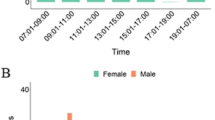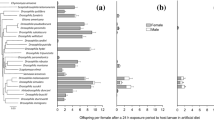Abstract
Trichopria drosophilae is a cosmopolitan pupal parasitoid that attacks many species of Drosophilidae, including the invasive Drosophila suzukii. This study reports on the life-history traits and host preferences of a Californian population of T. drosophilae and compares its life-time fecundity with a South Korean population of T. drosophilae. Female parasitoids emerge with a high mature egg-load (47.6 ± 2.3 eggs per female). The number of mature eggs of female T. drosophilae was affected by the female age and body size but not by the interaction between these two factors. The parasitoid did not show preference among differently aged (1–4 days old) D. suzukii pupae and host age did not affect the parasitoid’s fitness, except that offspring developmental time slightly increased with host age. In a choice test, more offspring successfully developed from the larger D. suzukii than the smaller D. melanogaster, and adult females reared from D. suzukii were larger than those that were reared from D. melanogaster, apparently at no cost in parasitoid fitness. T. drosophilae females from the Californian and the South Korean populations survived 27.5 and 20.2 days, produced a total of 63.8 and 52.0 offspring, and had an intrinsic rate of increase of 0.124 and 0.113, respectively, when provided with adult food and D. suzukii pupae as host material.





Similar content being viewed by others
References
Asplen M, Anfora G, Biondi A, Choi D-S, Chu D, Daane KM, Gibert P, Gutierrez AP, Hoelmer KA, Hutchison W, Isaacs RA, Jiang Z, Karpati Z, Kimura M, Pascual M, Philips C, Plantamp C, Ponti L, Vetek G, Vogt H, Walton VA, Yu Y (2015) Invasion biology of spotted wing drosophila (Drosophila suzukii): a global perspective and future priorities. J Pest Sci 681:469–494
Biondi A, Mommaerts V, Smagghe G, Vinuela E, Zappala L, Desneux N (2012) The non-target impact of spinosyns on beneficial arthropods. Pest Manag Sci 68:1523–1536
Biondi A, Desneux N, Amiens-Desneux E, Siscaro G, Zappalà L (2013) Biology and developmental strategies of the Palaearctic parasitoid Bracon nigricans (Hymenoptera: Braconidae) on the Neotropical moth Tuta absoluta (Lepidoptera: Gelechiidae). J Econ Entomol 106:1638–1647
Birch LC (1948) The intrinsic rate of natural increase of an insect population. J Anim Ecol 17:15–26
Bruck DJ, Bolda M, Tanigoshi L, Klick J, Kleiber J, DeFrancesco J, Gerdeman B, Spitler H (2011) Laboratory and field comparisons of insecticides to reduce infestation of Drosophila suzukii in berry crops. Pest Manag Sci 67:1375–1385
Burrack HJ, Fernandez GE, Spivey T, Kraus DA (2013) Variation in selection and utilization of host crops in the field and laboratory by Drosophila suzukii Matsumara (Diptera: Drosophilidae), an invasive frugivore. Pest Manag Sci 69:1173–1180
Carton Y, Boulétreau B, van Alphen JJM, van Lenteren JC (1986) The Drosophila parasitic wasps. In: Ashburner M, Carson HL, Thompson JN (eds) The genetics and biology of Drosophila, vol 3. Academic Press, London, pp 347–394
Chabert S, Allemand R, Poyet M, Eslin P, Gibert P (2012) Ability of European parasitoids (Hymenoptera) to control a new invasive Asiatic pest, Drosophila suzukii. Biol Control 63:40–47
Cini A, Anfora G, Escudero-Colomar LA, Grassi A, Santosuosso U, Seljak G, Papini A (2014) Tracking the invasion of the alien fruit pest Drosophila suzukii in Europe. J Pest Sci 87:559–566
Daane KM, Wang XG, Duerr SS, Kuhn EJ, Son Y, Yokota GY (2013) Biology of Habrobracon gelechiae (Hymenoptera: Braconidae), as a parasitoid of the obliquebanded leafroller (Lepidoptera: Tortricidae). Environ Entomol 42:107–115
Dalton DT, Walton VM, Shearer PW, Walsh DB, Caprile J, Isaacs R (2011) Laboratory survival of Drosophila suzukii under simulated winter conditions of the Pacific Northwest and seasonal field trapping in five primary regions of small and stone fruit production in the United States. Pest Manag Sci 67:1368–1374
Fleury F, Ris N, Allemand R, Fouillet P, Carton Y, Boulétreau M (2004) Ecological and genetic interactions in Drosophila-parasitoids communities: a case study with D. melanogaster, D. simulans and their common Leptopilina parasitoids in south-eastern France. Genetica 120:181–194
Fleury F, Gibert P, Ris N, Allemand R (2009) Ecology and life history evolution of frugivorous Drosophila parasitoids. In: Prevost G (ed) Advances in parasitology: parasitoids of Drosophila, vol 70. Elsevier, London, pp 3–44
Gabarra R, Riudavets J, Rodríguez GA, Pujade-Villar J, Arnó J (2015) Prospects for the biological control of Drosophila suzukii. BioControl 60:331–339
Goodhue RE, Bolda M, Farnsworth D, Williams JC, Zalom FG (2011) Spotted wing drosophila infestation of California strawberries and raspberries: economic analysis of potential revenue losses and control costs. Pest Manag Sci 67:1396–1402
Hamby KA, Bolda MP, Sheehan ME, Zalom FG (2014) Seasonal monitoring for Drosophila suzukii (Diptera: Drosophilidae) in California commercial raspberries. Environ Entomol 43:1008–1018
Kacsoh BZ, Schlenke TA (2012) High hemocyte load is associated with increased resistance against parasitoids in Drosophila suzukii, a relative of D. melanogaster. PLoS ONE 7:e34721
Klick J, Lee JC, Hagler JR, Bruck DJ, Yang WQ (2014) Evaluating Drosophila suzukii immunomarking for mark-capture research. Entomol Exp Appl 152:31–41
Lee JC, Bruck DJ, Curry H, Edwards D, Haviland DR, van Steenwyk RA, Yorgey BM (2011) The susceptibility of small fruits and cherries to the spotted-wing drosophila, Drosophila suzukii. Pest Manag Sci 67:1358–1367
Lee JC, Dreves AJ, Cave AM, Kawai S, Isaacs R, Miller JC, van Timmeren S, Bruck DJ (2015) Infestation of wild and ornamental noncrop fruits by Drosophila suzukii (Diptera: Drosophilidae). Ann Entomol Soc Am 108:117–129
Miller B, Anfora G, Buffington M, Daane KM, Dalton DT, Hoelmer KM, Rossi Stacconi MV, Grassi A, Ioriatti C, Miller J, Quantar M, Wang XG, Wiman N, Loni A, Walton VW (2015) Seasonal occurrence of resident parasitoids associated with Drosophila suzukii in two small fruit production regions of Italy and the USA. Bull Insectol 68:255–263
Mitsui H, Takahashi KH, Kimura MT (2006) Spatial distributions and clutch sizes of Drosophila species ovipositing on cherry fruits of different stages. Popul Ecol 48:233–237
Mitsui H, van Achterberg K, Nordlander G, Kimura MT (2007) Geographical distributions and host associations of larval parasitoids of frugivorous Drosophilidae in Japan. J Nat Hist 41:1731–1738
Morris RJ, Fellowes MDE (2002) Learning and natal host influence host preference, handling time and sex allocation behaviour in a pupal parasitoid. Behav Ecol Sociobiol 51:386–393
Nomano FY, Mitsui H, Kimura MT (2015) Capacity of Japanese Asobara species (Hymenoptera; Braconidae) to parasitize a fruit pest Drosophila suzukii (Diptera; Drosophilidae). J Appl Entomol 139:105–113
Otto M, Mackauer M (1998) The developmental strategy of an idiobiont ectoparasitoid, Dendrocerus carpenteri: influence of variations in host quality on offspring growth and fitness. Oecologia 117:353–364
Poyet M, Havard S, Prévost G, Chabrerie O, Doury G, Gibert P, Eslin P (2013) Resistance of Drosophila suzukii to the larval parasitoids Leptopilina heterotoma and Asobara japonica is related to haemocyte load. Physiol Entomol 38:45–53
Prévost G (2009) Advances in parasitology. Parasitoids of Drosophila, vol 70. Academic Press, London
Quicke DJ (1997) Parasitic wasps. Chapman and Hall, London
Rojas P, Rodríguez-Leyva E, Lomeli-Flores Liu T-X (2015) Biology and life history of Tamarixia triozae, a parasitoid of the potato psyllid Bactericera cockerelli. BioControl 60:27–35
Rossi Stacconi MV, Buffington M, Daane KM, Dalton DT, Grassi A, Kaçar G, Miller B, Miller JC, Baser N, Ioriatti C, Walton VM, Wiman NG, Wang XG, Anfora G (2015) Host stage preference, efficacy and fecundity of parasitoids attacking Drosophila suzukii in newly invaded areas. Biol Control 84:28–35
Stewart TJ, Wang XG, Molinar A, Daane KM (2014) Factors limiting peach as a potential host for Drosophila suzukii (Diptera: Drosophilidae). J Econ Entomol 107:1771–1779
Tochen S, Dalton DT, Wiman N, Hamm C, Shearer PW, Walton VM (2014) Temperature-related development and population parameters for Drosophila suzukii (Diptera: Drosophilidae) on cherry and blueberry. Environ Entomol 43:501–510
van Lenteren JC (2012) The state of commercial augmentative biological control: plenty of natural enemies, but a frustrating lack of uptake. BioControl 57:1–20
Walsh DB, Bolda MP, Goodhue RE, Dreves AJ, Lee J, Bruck DJ, Walton VM, O’Neal SD, Zalom FG (2011) Drosophila suzukii (Diptera: Drosophilidae): invasive pest of ripening soft fruit expanding its geographic range and damage potential. J Integr Pest Manag 2:G1–G7
Wang XG, Messing RH (2004a) The ectoparasitic pupal parasitoid, Pachycrepoideus vindemmiae (Hymenoptera: Pteromalidae), attacks other primary tephritid fruit fly parasitoids: host expansion and potential non-target impact. Biol Control 31:227–236
Wang XG, Messing RH (2004b) Fitness consequences of body-size-dependent host species selection in a generalist ectoparasitoid. Behav Ecol Sociobiol 56:513–522
Wang XG, Liu SS, Guo SJ, Lin WC (1999) Effects of host stages and temperature on population parameters of Oomyzus sokolowskii, a larval-pupal parasitoid of Plutella xylostella. BioControl 44:391–402
Wiman NG, Walton VM, Dalton DT, Anfora G, Burrack HJ, Chiu JC, Daane KM, Grassi A, Miller B, Tochen S, Wang X, Ioriatti C (2014) Integrating temperature-dependent life table data into a matrix projection model for Drosophila suzukii population estimation. PLoS ONE 9:e106909
Zappala L, Biondi A, Alma A, Al-Jboory IJ, Arno J, Bayram A, Chailleux A, El-Arnaouty A, Gerling D, Guenaoui Y, Shaltiel-Harpaz L, Siscaro G, Stavrinides M, Tavella L, Aznar RV, Urbaneja A, Desneux N (2013) Natural enemies of the South American moth, Tuta absoluta, in Europe, North Africa and Middle East, and their potential use in pest control strategies. J Pest Sci 86:635–647
Acknowledgments
Funding for research was supported by the California Cherry Board and the USDA APHIS (Farm bill, fund 14-8130-0463). We thank Jeffrey Miller, Peter Shearer, and Betsey Miller (Oregon State University) for foreign exploration in South Korea (funded by the USDA-NIFA award # 2010-51181-21167); Matthew Buffington (USDA-ARS) for the identification of the parasitoid; John Hutchins and Marilyn Chan (University of California, Berkeley) for assistance in colony maintenance. We also thank Betsey Miller for useful comments on an early version of this manuscript. Gülay Kaçar was supported by the Scientific and Technological Research Council of Turkey (TUBITAK); Antonio Biondi received funding from the People Programme (Marie Curie Actions) of the European Union’s Seventh Framework Programme FP7/2007-2013/under REA Grant agreement 318246 and from the Italian Ministry of Education, University and Research (PRIN project GEISCA, 2010CXXHJE 004); Marilyn Chan was supported by Sponsored Projects for Undergraduate Research (SPUR).
Author information
Authors and Affiliations
Corresponding author
Additional information
Handling Editor: Josep Anton Jaques Miret.
Rights and permissions
About this article
Cite this article
Wang, XG., Kaçar, G., Biondi, A. et al. Life-history and host preference of Trichopria drosophilae, a pupal parasitoid of spotted wing drosophila. BioControl 61, 387–397 (2016). https://doi.org/10.1007/s10526-016-9720-9
Received:
Accepted:
Published:
Issue Date:
DOI: https://doi.org/10.1007/s10526-016-9720-9




